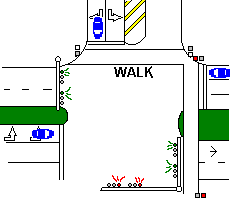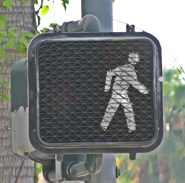First, remember: You're sharing the road with pedestrians... and they have the right-of way!

While WALK is on for pedestrians, vehicle traffic also may have a green light. As seen in the diagram at the right, with the crosswalk shown at the top of the intersection, cars may turn into a crosswalk from three directions, even though pedestrians have the right-of-way. Vehicles with a GREEN light (such as those at the left and right sides of the intersection) might turn left or right into the crosswalk. Vehicles with a RED light (such as the one just above the crosswalk in the diagram) are usually permitted to turn "right on red." However, vehicle traffic must always yield to pedestrians!
Here in Tallahassee...
Law requires that the bumper or most forward part of the vehicle be behind the stop bar.
Where is the detection zone? Vehicle sensors are "loops" of wire embedded in the pavement. Typically, left turn loops are 60 feet long and those in through lanes are 20 feet long. They start at the stop bar on each approach as depicted in purple in the above drawing.
We are also deploying a relatively new technology, video detection, in which detection zones are drawn on the background of the static video of an approach to an intersection. When the background changes due to a vehicle's pulling into the detection zone, a signal is sent to the traffic signal controller, which causes the light to change eventually. This new video-based system uses the same size zones as the signal loops.
Main streets usually get more green time
While waiting for the light to change on a side street, remember that most traffic is moving on main streets.
What's a full timing cycle?
Major streets come together at some intersections. Each direction might get 60 seconds (or more) of GREEN time. Consider left turns, straight traffic, and yellow signal timing for each direction. A full cycle at a given intersection might take several minutes. When traffic in opposing directions is light, a couple of minutes' waiting can certainly seem like ten!
Traffic engineers attempt to move the greatest volume of traffic in the shortest amount of time.
Signals are usually programmed so that each intersection is "timed" to work with other intersections. While 2, 4, 8, 16, or however many cars are waiting for a light to change on a minor street, 16, 32, 64, or more cars might move along the major street. Based on traffic volume data (which varies from day to day), it is sometimes best to hold the minor street RED for a specific period of time (causing traffic to "stack up"), while allowing a greater volume of traffic to travel through GREEN signals on the major street.

Remember the effect of pedestrian signal timing.
A pedestrian may have activated a "WALK" signal. Pedestrian signal timing is the combination of both "WALK" and flashing "DON'T WALK." The pedestrian may still be crossing the intersection. However, once the signal is activated, it will come on even if the pedestrian has already crossed during a break in traffic.
And remember, pedestrians always have the right of way at an intersection.
Flashing Yellow Arrow
The City of Tallahassee has installed a new traffic signal designed to make our roadways safer and more efficient. Flashing Yellow Arrow Traffic Signals feature a flashing yellow arrow that allows motorists to make an indicated turn after yielding to oncoming traffic.
- The red arrow means STOP. No turns are allowed.
- The solid yellow arrow alerts motorists that they should be prepared to stop or complete their turn.
- The flashing yellow arrow means that turns are allowed. Motorists must yield to pedestrians in the crosswalk and oncoming traffic as oncoming traffic has a green light.
- The green arrow means GO. It is safe to turn; oncoming traffic must stop.
Studies by the Federal Highway Administration have shown that flashing yellow arrows can help reduce left-turn crashes by 35 percent. In addition to enhanced safety, the national study found that flashing yellow arrows are easier to understand versus the traditional yield-on-green indicators, which are represented by a solid green circle. The new traffic signal also provides traffic engineers with more options to handle variable traffic volumes, saving motorists time and fuel.
Still think the timing is off?
You can report the issue using DigiTally, the City's customer service mobile app, or by calling 850-891-4968.
(If a signal is completely out and you have a cell phone, dial *COP to be connected to the Tallahassee Police Department, which will dispatch one or more officers to assist with traffic control.)
Version: 2553 (1/15/2016 10:00 AM) |